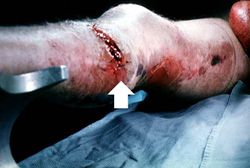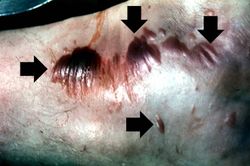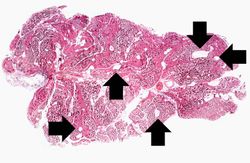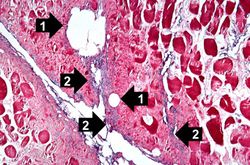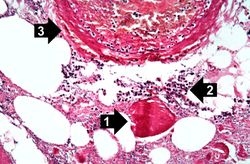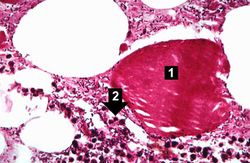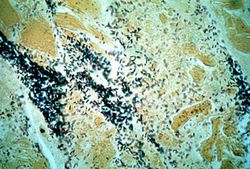Difference between revisions of "IPLab:Lab 9:Clostridial Myonecrosis"
Seung Park (talk | contribs) |
Seung Park (talk | contribs) |
||
| Line 22: | Line 22: | ||
Theta toxin binds cholesterol and forms a membrane-destabilizing pore that causes leukocyte lysis, explaining the paucity of polymorphonuclear leukocytes in the lesions of gas gangrene.</spoiler> | Theta toxin binds cholesterol and forms a membrane-destabilizing pore that causes leukocyte lysis, explaining the paucity of polymorphonuclear leukocytes in the lesions of gas gangrene.</spoiler> | ||
| + | |||
| + | == Additional Resources == | ||
| + | === Reference === | ||
| + | |||
| + | |||
| + | === Journal Articles === | ||
| + | |||
| + | |||
| + | === Images === | ||
| + | |||
| + | |||
| + | == Related IPLab Cases == | ||
| + | |||
{{IPLab 9}} | {{IPLab 9}} | ||
[[Category: IPLab:Lab 9]] | [[Category: IPLab:Lab 9]] | ||
Revision as of 04:23, 23 August 2013
Contents
Clinical Summary[edit]
This 68-year-old white male with insulin-dependent diabetes was admitted one day before his death. The chief complaints were the occurrence of chills and fever since passing a kidney stone two days earlier. In the last day, the right leg had become swollen. The most striking physical findings were redness of the right posterior calf and crepitance in both legs. The patient's white blood cell count was found to be 34,000 cells/cmm and the packed red blood cell volume (PCV) was 18%. Within hours, the right calf became tense and the crepitance spread up to the nipple line. The patient vomited, aspirated the vomitus, and died 10 hours after admission.
Images[edit]
This is a high-power photomicrograph of skeletal muscle. The muscle cells are hypereosinophilic and most do not contain nuclei, indicating that these cells are dead or dying. The round clear spaces (1) in this tissue correspond to gas accumulations prior to death. In between the bundles of muscle cells, accumulations of small dark blue-staining bacterial organisms can be seen (2). Also note that there is no inflammatory response in this tissue.
Study Questions[edit]
Additional Resources[edit]
Reference[edit]
Journal Articles[edit]
Images[edit]
Related IPLab Cases[edit]
| |||||
A normal hematocrit for a male is 39 to 49%.
